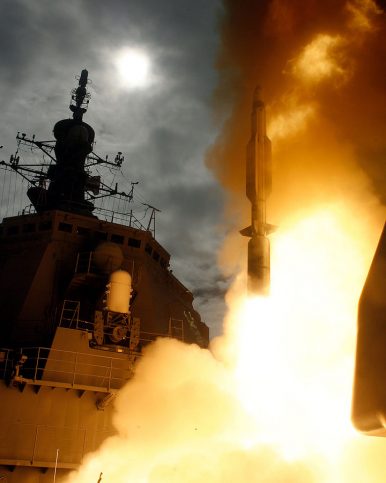By Yuki Tatsumi
 Two weeks have passed since North Korea test-launched the Hwasong-15, Pyongyang’s most advanced nuclear-capable inter-continental ballistic missile (ICBM). Prior to this November 29 test, there was debate among Korean affairs experts over whether a seeming suspension of missile tests by North Korea (no test had been conducted since September 15) might be a gesture on Pyongyang’s part to hint that they may be ready to talk. But the most recent test ended such debate, at least for now. More importantly, the latest test confirmed what U.S. Secretary of Defense James Mattis said months ago — that North Korea is “the most urgent and dangerous threat to peace and security.”
Two weeks have passed since North Korea test-launched the Hwasong-15, Pyongyang’s most advanced nuclear-capable inter-continental ballistic missile (ICBM). Prior to this November 29 test, there was debate among Korean affairs experts over whether a seeming suspension of missile tests by North Korea (no test had been conducted since September 15) might be a gesture on Pyongyang’s part to hint that they may be ready to talk. But the most recent test ended such debate, at least for now. More importantly, the latest test confirmed what U.S. Secretary of Defense James Mattis said months ago — that North Korea is “the most urgent and dangerous threat to peace and security.”
In the days immediately following the test, most of the world’s attention was on the question of “now what?” — and appropriately so. U.S. President Donald Trump said, several hours after the test, that the United States “will take care of it” and that the missile launch is “a situation that we will handle.” The challenge that North Korea presents, however, is that there is no good way for the United States to “take care of it,” unless not only the United States but China, Japan, South Korea, Russia, and the countries that are members of the United Nations Command in South Korea agree that military action is the only way to proceed.
The world’s response in the last two weeks indeed confirmed the absence of good options. Speculation about a U.S. preventative strike against Pyongyang (fueled by comments from prominent political figures, including Senator Lindsay Graham) continue to swirl. However, as Mattis has said, a diplomatic solution clearly remains a preferred option not only for the United States but also for all the countries that have a stake in avoiding another armed conflict on the Korean Peninsula.
While the world continues to search for a diplomatic resolution, one thing is clear for Japan — Tokyo needs to adapt to the current “new normal” of prolonged periods of high alert vis-à-vis North Korea, and update its defense posture accordingly. It has already taken steps to pave the way for acquiring new assets and capabilities that enhance Japan’s capability to defend itself from North Korea’s missile threats. Before the end of the year, the government is expected to determine whether Tokyo will acquire Aegis Ashore or Terminal High Altitude Area Defense (THAAD) as additional missile defense assets. In addition, Tokyo is reportedly looking to purchase Long-Range Anti-Ship Missiles (LRASM) and Joint Air-to-Surface Standoff Missiles, with an eye toward also purchasing Joint Strike Missiles (JSM).
Given the heightening tension on the Korean Peninsula, enhancement of missile defense capability will most certainly be among the top priorities as Japan prepares to revise its National Defense Program Guidelines (NDPG) and the Mid-Term Defense Program (MTDP) next year. The former is an approximate equivalent of the U.S. Quadrennial Defense Review (QDR); the latter a close equivalent of the U.S. Five-Year Defense Plan (FYDP). During the process of revising the NDPG and MTDP, the question of whether Japan should acquire the long-range strike capabilities that would enable Tokyo to preemptively attack North Korea when a missile launch from Pyongyang is anticipated will be a topic of robust discussion.
There is no question that Japan needs to enhance its defense posture to better protect the country from North Korea’s missile threat. The central challenge for the defense planners in Tokyo, though, is how to balance among competing priorities, namely among (1) enhanced defense against missile threats, (2) continued development of amphibious capabilities, and (3) improvements to Japan’s cybersecurity capacity to better protect C4ISR assets across the three Japan Self-Defense Force (JSDF) services— critical to improve the capability to conduct joint operations .
The problem for Japan’s defense planners is that these priorities have to be reconciled with the pricy investment decisions that Japan has made under the current NDPG and MTDP to modernize its capabilities, including the acquisition of F-35A aircraft, MV-22 Ospreys, and Amphibious Assault Vehicles (AAV). While Japan’s annual defense budget has finally begun to see a much-needed increase after close to a decade of flat or reduced defense budget, the increase will likely not be sufficient to resource the acquisition of these new capabilities without moving resources away from other items, such as personnel, training, and repair and maintenance. However, the resources for these items are critical in maintaining the readiness of the force. Inadequate resource for readiness will result in the hollowing-out of the force, which would be extremely difficult to recover from. This leaves very few choices other than pursuing s defense budget increase that is more substantial than the previous few years.
Since assuming the office in December 2012, Prime Minister Shinzo Abe has consistently talked about Japan bearing greater responsibility in its own defense. Whether he can get behind a substantial increase of defense budget to that end, despite his country’s non-defense priorities, will be one of the critical factors in Japan’s defense planning in the coming years.
No comments:
Post a Comment